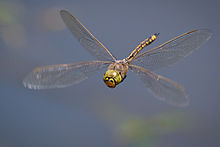Australian emperor
| Australian emperor | |
|---|---|

| |
| Scientific classification | |
| Domain: | Eukaryota |
| Kingdom: | Animalia |
| Phylum: | Arthropoda |
| Class: | Insecta |
| Order: | Odonata |
| Infraorder: | Anisoptera |
| Family: | Aeshnidae |
| Genus: | Anax |
| Species: | A. papuensis
|
| Binomial name | |
| Anax papuensis (Burmeister, 1839)[2]
| |

| |
| Synonyms[3] | |
| |
The Australian emperor dragonfly,[4] also known as the yellow emperor dragonfly,[5] scientific name Anax papuensis, is a species of dragonfly in the Aeshnidae family.[3] It is black with yellow dots along its tail.[6]
Description
[edit]
The Australian emperor is a very large dragonfly, up to 70 mm long. Its abdomen is marked boldly in black and yellow. The thorax is greenish-grey. The head is yellow with a T-shaped mark on the forehead (frons). The eyes are yellow-green. The leading edges of the wings are yellow. The insect habitually hunts fairly slowly, patrolling up and down like other hawkers, with short bursts at high speed.[7]
Their wingspan is 11 centimetres (4.3 in). Males and females are similar.[8]
Distribution and habitat
[edit]The Australian emperor is found throughout Australia. In the state of Victoria, it has a split distribution: below about 600 metres in altitude, and above about 1200 metres, apparently because it avoids forested areas. It is also found in New Zealand, New Guinea, the Cocos-Keeling Islands, Java, Sumba and New Caledonia.[9][10]
The Australian emperor is widespread and common on larger bodies of water with tall vegetation on the banks. Like other hawkers, it may hunt far from water. It flies throughout the summer from September to May.[7]
Behaviour
[edit]
The Australian emperor is notable as the dragonfly in which motion camouflage was studied by Mizutani et al.: males of Anax papuensis are fiercely territorial, and approach and attack rivals, the males choose a flight path that keeps their image as seen by the target still with respect to a landmark point. The attacking dragonfly thus looms larger in the target's eyes, but otherwise does not seem to move until it is very close.[11][12][13]
The males are very protective of their females. In case of intrusion of another individual, he will drive it away by engaging in a series of noisy air battles. Females lay their eggs under water.[5]
Gallery
[edit]-
Australian emperor has a wingspan of about 11 cm
-
Male in flight
-
Hatching of larva
-
Female wings
-
Male wings
Bibliography
[edit]- Günther Theischinger and John Hawking. The Complete Field Guide to Dragonflies of Australia. CSIRO Publishing, 2006. ISBN 978 0 64309 073 6
See also
[edit]References
[edit]- ^ Rowe, R. (2017). "Anax papuensis". IUCN Red List of Threatened Species. 2017: e.T197096A83372051. doi:10.2305/IUCN.UK.2017-1.RLTS.T197096A83372051.en. Retrieved 20 November 2021.
- ^ Burmeister, Hermann (1839). Handbuch der Entomologie (in Latin and German). Vol. 2. Berlin: T.C.F. Enslin. pp. 805–862 [841] – via Biodiversity Heritage Library.
- ^ a b "Species Anax papuensis (Burmeister, 1839)". Australian Faunal Directory. Australian Biological Resources Study. 2012. Retrieved 23 January 2017.
- ^ "Common name". Brisbane Insects. Retrieved April 27, 2012.
- ^ a b "Second common name and habitat". Oocities. Retrieved April 27, 2012.
- ^ "Colour". Archived from the original on 2012-03-27. Retrieved 2013-06-28.
- ^ a b Hemianax papuensis Retrieved 16 January 2012
- ^ Description Archived April 26, 2013, at the Wayback Machine
- ^ Esperance Fauna Retrieved 16 January 2012
- ^ Theischinger, 2006.
- ^ Hopkin, Michael (June 5, 2003). "Nature News". Dragonfly Flight Tricks the Eye. Nature.com. doi:10.1038/news030602-10. Retrieved January 16, 2012.
- ^ Mizutani, A. K.; Chahl, J. S. & Srinivasan, M. V. (June 5, 2003). "Insect behaviour: Motion camouflage in dragonflies". Nature. 65 (423): 604. Bibcode:2003Natur.423..604M. doi:10.1038/423604a. PMID 12789327.
- ^ Glendinning, Paul (27 January 2004). "Motion Camouflage". The Mathematics of Motion Camouflage. 271 (1538): 477–81. doi:10.1098/rspb.2003.2622. PMC 1691618. PMID 15129957.






